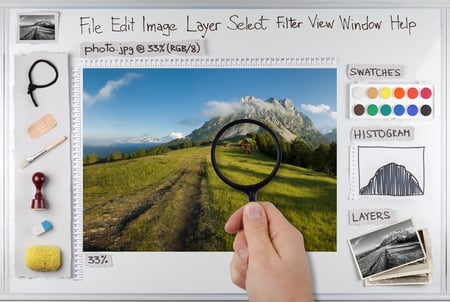Like “Google” and “Shop-Vac”, “Photoshop” is so popular it has actually become its own verb. It's one of the best known software applications on Earth, and has a reputation for being hard to learn, but it doesn’t have to be th at way. While it’s a bit too complicated to learn from one blog post, we can break down some of the broad functions. Let’s look at a few tools that are most commonly used in Photoshop:
at way. While it’s a bit too complicated to learn from one blog post, we can break down some of the broad functions. Let’s look at a few tools that are most commonly used in Photoshop:
1) The Layer Tool
The Layer Tool is easily the most important aspect of Photoshop, and one that can be the most challenging to newbies. A layer can be used for an image, text, brush strokes, background colors, patterns, and filters- pretty much anything. Think of layers as transparent sheets stacked on top of one another that you'll use to create your final product. Each sheet can be modified individually without affecting the project as a whole, then placed on top of each other to create the final image. You can add, delete, and even duplicate layers to make your life a lot easier- just remember to name them!
2) The Color and Swatches Tool
The Color and Swatches tool lets you do a lot, like use, modify, copy, and even save custom colors for your piece. While this may seem like a simple element, in can increase your effeciency and has powerful features that may not be self-explanatory but will keep you  from mixing up your colors. To make sure you don’t start using the wrong shades, take your company colors and save them as “Swatches” so that you can reference and reuse them whenever you’re using Photoshop.
from mixing up your colors. To make sure you don’t start using the wrong shades, take your company colors and save them as “Swatches” so that you can reference and reuse them whenever you’re using Photoshop.
3) Custom Fonts and Text Tool
The Text Tool allows you to add custom fonts to your database, and it gives you access to advanced font settings that give your text some unique style. Like the Color and Swatches Tool, it will prevent you from accidentally mixing things up in the middle of a piece. When you create a text box, Photoshop will automatically generate a layer for it. You then choose the color, size, stroke, font style, and a variety of other options to switch things up.
4) Custom Brushes and The Brush Tool
Brushes are a great way to add some visual accents to your content. Photoshop automatically give you a pretty good selection of brush tips that you can use to clean up your graphics and create some basic visual effects. Just as with fonts and colors, you can add your own, royalty-free, custom brush tips. With the brush settings, you can change the size, shape, and transparency of your brush strokes to achieve a number of different visu al effects. Then, save them and keep for for future projects.
al effects. Then, save them and keep for for future projects.
5) The Fill Tool
The Fill Tool, similar to a paint bucket tool, fills an entire area with a color. This part is pretty easy and doesn’t need much description. What’s particularly interesting about Photoshop’s Fill Tool however is that you can also manually create patterns to fill the blank space as well. If that’s too time consuming or difficult, you can also upload a pattern you find through a relatively simple Google search (royalty free, of course!).
6) The Eyedropper
The Eyedropper Tool is one of the most useful tools in Photoshop, in my opinion. It lets you extract and use any color from any image in Photoshop and save it be one of your custom colors. This makes getting your company’s custom colors into Photoshop extremely easy and precise. It’s simple, just select the icon from the sidebar. Next, locate that color you would like to extract from your image, and simply click that area to clone the color. You can then use it as will and save it for future use.
There is of course, many other tools used in Photoshop. If you’ve ever used something like Microsoft Paint, these tools will be familiar. Many of which, like the crop tool or the eraser don’t need to be explained. If you the reason you think you need more advanced help in Photoshop is because you’re concerned about an outdated logo or marketing materials, Impulse Creative can help! Download our free eBook DIY Brand Audit Guide. Consistent branding, like what you can achieve with quality Photoshop skills, is the first step to building an emotional connection to your consumers!





